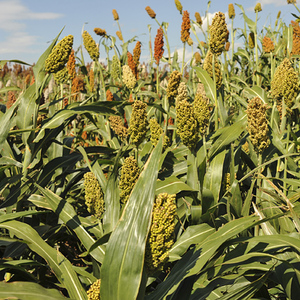USDA ARS: Tapping sorghum's genetic potential




Robert Klein
September 23, 2016
BY Dennis O'Brien, USDA Agricultural Research Service
An Agricultural Research Service plant geneticist has developed new genetic resources that allow the breeding of sorghum varieties with higher grain yields and greater resistance to diseases and pests.
The work by Robert R. Klein and his colleagues is important because with climate change and water shortages, sorghum is becoming an attractive alternative to U.S. crops that require more water. Sorghum also is a critical option for staving off hunger overseas.
Decades of breeding has produced sorghum suitable for a swath of 14 States extending from Texas to South Dakota. This year’s U.S. crop is worth an estimated $1.9 billion.
Advertisement
Breeding new varieties for growers in the United States and other temperate regions is challenging because sorghum originated in the tropics. Many tropical sorghums flower when day lengths are short. By the time the days are short enough for flowering in temperate regions, it’s often too cold to produce a sorghum crop with sufficient grain.
Klein and his colleagues selected sorghum lines for cross breeding from the ARS Plant Genetic Resources Conservation Unit in Griffin, Georgia, that were known for producing high grain yields in countries such as Sudan and Ethiopia. Because they were originally from sorghum’s center of origin in Africa, the lines selected would not flourish in temperate regions. But they had the potential to produce high grain yields while offering resistance to some of Mother Nature’s most daunting threats.
The researchers used both molecular and traditional breeding techniques to “convert” tall, late-flowering tropical sorghum plants into lines that mature faster and come equipped with genes for producing high grain yields.
The results, published in the Journal of Plant Registrations, will help ensure sorghum’s future as an economically viable crop. They also demonstrate the value of the ARS sorghum collection in Griffin, where lines from around the world are kept viable.
Advertisement
Read more about this research in the September 2016 issue of AgResearch.
ARS is the U.S. Department of Agriculture’s chief in-house scientific research agency.
Related Stories
The U.S. Department of Energy Bioenergy Technologies Office (BETO) announced up to $23 million in funding to support research and development (R&D) of domestic chemicals and fuels from biomass and waste resources.
The U.S. DOE has announced its intent to issue funding to support high-impact research and development (R&D) projects in two priority areas: sustainable propane and renewable chemicals and algal system cultivation and preprocessing.
Sens. Sherrod Brown, D-Ohio, and Pete Ricketts, R-Neb., in August introduced the Renewable Chemicals Act, a bill that aims to create a tax credit to support the production of biobased chemicals.
The Chemical Catalysis for Bioenergy Consortium, a consortium of the U.S. DOE’s Bioenergy Technologies Office, has launched an effort that aims to gather community input on the development of new biomass processing facilities.
USDA on March 8 celebrated the second annual National Biobased Products Day, a celebration to raise public awareness of biobased products, their benefits and their contributions to the U.S. economy and rural communities.
Upcoming Events










